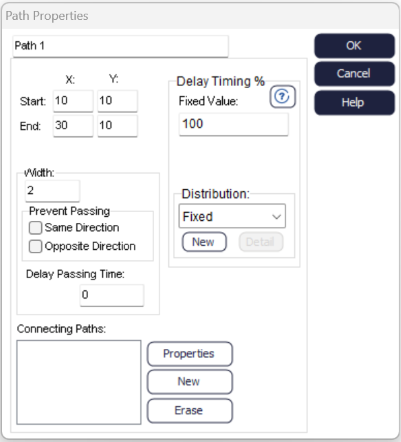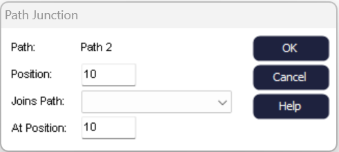Paths
A path network consists of one or more paths. Once a Work Item enters a path network (on a Vehicle) it can travel to anywhere in that path network provided the paths are connected.
Work enters and leaves path networks via Loaders.
A path network consists of a number of connected paths. Use the Path Networks dialog, accessible from View by Type menu on the Build tab to create paths.
Use the New path button to create new paths. For each path, inspect its properties by clicking the path name and the properties button.

The X, Y, Start , End fields define the position of the path in the simulation. These are in feet (meters) from the top left of the window.
The width of the path defines (along the Vehicle widths) whether a given pair of Vehicles can pass each other on this path.
If the width is not widen enough for two Vehicles to pass Simul8 will consider the 'Prevent Passing' and the 'Delay Passing' boxes. (Note: these are ONLY considered IF the width is NOT wide enough to pass. The default Vehicle width is 1 and the default path width is 2, so by default Vehicles can pass and the 'Prevent Passing' and 'Passing Delay' parameters are not considered.)
When width does constrain:
- If Prevent Passing Same Direction is checked a fast Vehicle cannot overtake a slow Vehicle.
- If Opposite Direction is checked then two Vehicles approaching each other head-on cannot pass. (The simulation will stop and explain why).
- If one or other of the above are NOT checked, then Simul8 will use the Delay Passing Time to delay the Vehicles while they move around each other.
Delays can also be caused to Vehicles because the area around a path is busy with people and other non-simulated items. The Delay Timing % box can be used to interrupt a Vehicle's travel along a path by a desired percentage. No delays occur with the timing delay set to Fixed 0. Otherwise a percentage delay is sampled from a distribution and this is used to stop the Vehicle a number of times along the path to create the sampled delay percentage.
Fixed 50 would mean all Vehicles take 50% more time than they should to travel the path. Fixed 100 would mean all Vehicles take twice the expected time to travel the path. Only positive values are sampled. These delays are included in the Delayed by Traffic Result.
Connect paths together using the Connecting Path NEW and Properties buttons.

In this case Path 1 is connected to path 2. Position 0 on path 2 is at the same physical location in the simulation as position 10 on Path 1.